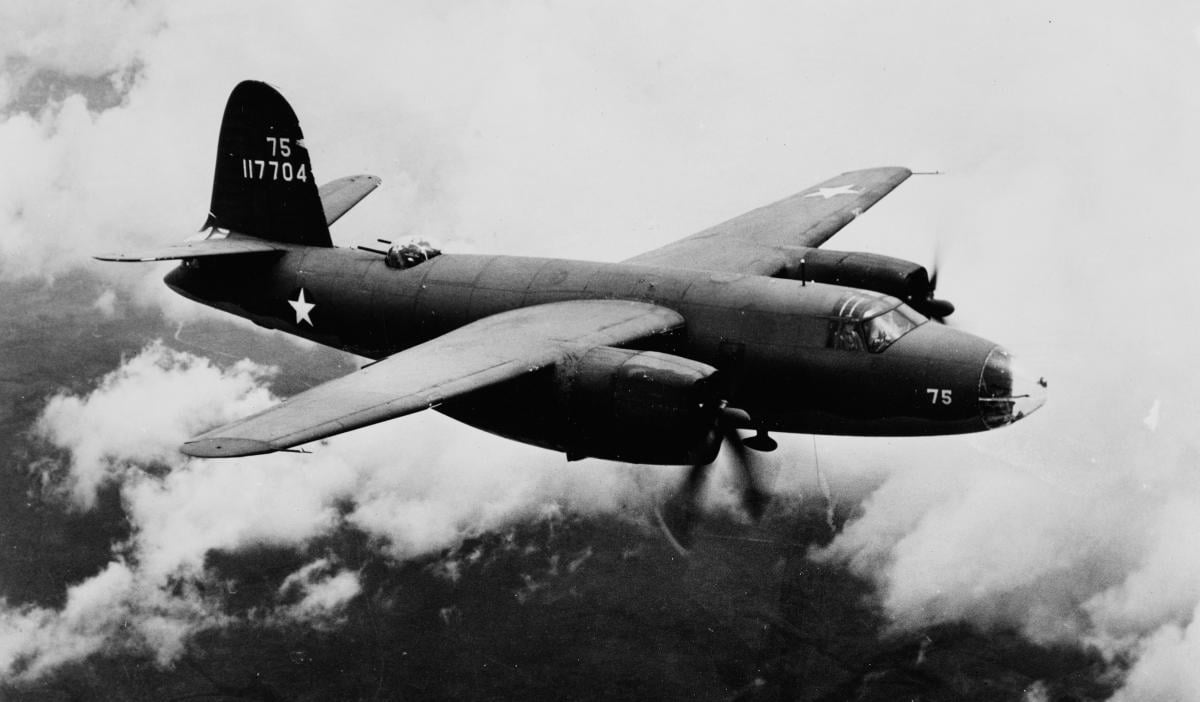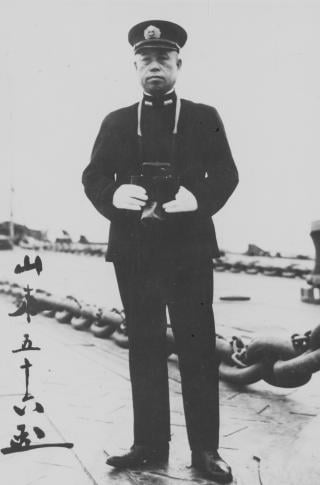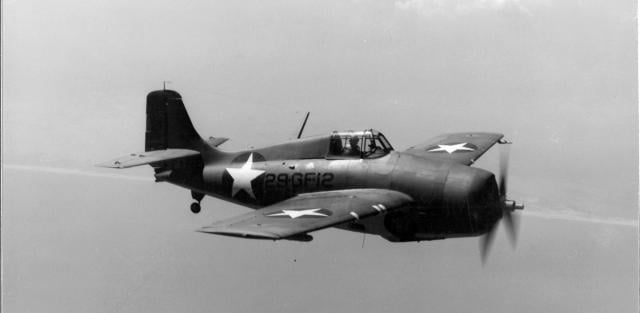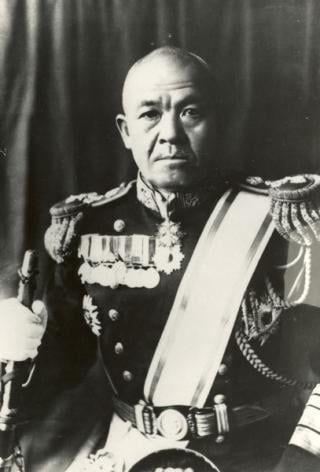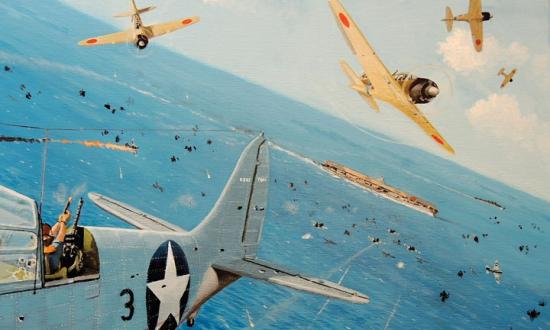History has viewed the June 1942 Battle of Midway primarily through a naval lens. Rightfully so. It is indeed the most famous naval engagement in the history of the United States. Like Salamis, the Spanish Armada, and Trafalgar, the Battle of Midway determined the momentum of a war—in this case, the war in the Pacific. On the heels of Pearl Harbor, Bataan, and Corregidor, Midway not only turned the tide, but came to symbolize the American spirit to resist an overwhelming series of setbacks.
(U.S. Naval Institute Photo Archive)
However, despite the dark days of 1941 and 1942, the Imperial Japanese supernova of strategic expansion across the Pacific was beginning to show signs of its limitations. Six months after Pearl Harbor, one final offensive by Japan’s mobile striking force of carriers, Kido Butai, was to lure America’s only strategic assets left in the Pacific, her own precious carriers. Admiral Isoroku Yamamoto conceived the operation to drive into the Central Pacific and the Aleutians to inch further toward Hawaii and conquer U.S. territory, destroying the American will to carry on the struggle in favor of a negotiated settlement that would ensure Japanese primacy in the Pacific. More than anyone in the Imperial High Command, Yamamoto understood the importance of striking a death-dealing blow against the Americans that would leave the door open for negotiations and bring a swift and rapid peace before the industrial might of the United States would awaken to carry the war to Japan.
The U.S. Army Air Forces’ role in “America’s Salamis” at Midway would pave the way not only for much-needed doctrinal change, but a deep analysis of preconceived notions that sparked bitter interservice rivalries. This story is one of courageous U.S. land-based bomber crews flying alongside their brothers in the Marine Corps and Navy to stem the oncoming Kido Butai. Despite overwhelming odds, they played a vital role in producing fundamental instances of confusion and hesitation among the Japanese at vital moments that would delay the reaction time of the enemy and help save our carriers from a counterstrike. Lessons learned from this battle can help us understand not only the failures and successes of the past, but provide key learning points to develop the lethality of the joint force tomorrow.
After breaking the Imperial Navy’s JN-25 code, Admiral Chester Nimitz and his staff had determined that Midway would be Yamamoto’s next target. Japan’s mobile striking force carriers would form the center of the Yamamoto’s Midway operation. Two carrier divisions under the command of Admiral Chuichi Nagumo formed the center of Yamamoto’s plans. Carrier Division 1 consisted of the flagship Akagi and the Kaga. 1st Air Fleet Headquarters and staff would join Nagumo on board the Akagi. Carrier Division 2, under the command of Admiral Tamon Yamaguchi, was composed of the flagship Hiryu and the Soryu.
Kido Butai was to reduce Midway’s air and ground defense installations to prepare a landing force to take the island. This target was chosen with the hope that the last American carriers in the Pacific would come north from Pearl Harbor to defend it. Kido Butai then would locate the Americans and sink them. Midway would be taken, as well as the Aleutian Island chain in Alaska. The strategic defense perimeter would be firmly established, the U.S. carriers would be sent to the bottom, and Hawaii would fall under immediate threat of invasion.
It was believed that if the Japanese could take Oahu, it would represent a juicy bargaining chip for an armistice. Unfortunately for Admiral Yamamoto, the Americans were not at Pearl Harbor, ready to react to him, but instead were lying in wait, north of Midway, ready to destroy the Japanese force. Although the U.S. carriers were outnumbered by Kido Butai’s, a fourth American carrier was operational—the island of Midway itself.
Midway’s air component represented a joint detachment of Navy, Marine Corps, and Air Force squadrons. The joint air group would be under Navy command; however, the tactics and prewar doctrine of these young and mostly inexperienced aviators would prove to break the rapidly formed cohesion that was required among this striking force. Midway’s air group would be the first to meet Admiral Nagumo’s carriers on 4 June, but their gallant efforts would result in tragedy as most of the aircrew and aircraft involved were lost. Although this force inflicted little to no damage on Nagumo, in retrospect, it provided key variables that would open the door of opportunity for American carrier aircrews to deal the decisive blow.
Prewar Doctrine as Gospel
During the prewar period, the U.S. Army Air Corps—later the U.S. Army Air Forces—developed bombing doctrine that would bring nations to their knees. Daylight precision bombing was the doctrine of the day for those who graduated from the Air Corps Tactical School (ACTS) at Maxwell Field, Alabama. One doctrinal gospel developed by Air Force pioneers and taught at the ACTS indicated that enemy fleets could become vulnerable and decisively defeated by land-based air power.
The Air Force fundamentally believed that land-based strategic bombers could defeat an enemy fleet on the approach. Their long-range, mutual defense, and bomb loads would combine to make an impregnable force that could avoid antiaircraft fire from the ships below and force enemy combat air patrols to spend large amounts of time climbing to higher altitudes to meet the gun-bristling fortresses. This notion, on paper at least, seems plausible, except for the fact that for this theory to work against moving naval targets, active cooperation from the enemy below was required to score hits. Doctrinal understanding and personal beliefs of how to exactly employ their weapons would mark the separation of official ACTS-published field doctrine versus proponents of high-altitude bombing.
For example, the Air Corps Field Manual 1-10 specifically states, “Naval objectives free to maneuver are bombed from the lowest altitude consistent with bombing accuracy and proper security measures. Obviously, the lower the bombing altitude, the smaller the opportunity of the vessel to avoid the bombs by maneuver.” Many would ignore this doctrinal practice in favor of high-altitude attacks against shipping, but this would require more bombers than would be available at Midway.
Day of Days
On the morning of 4 June 1942, U.S. Navy PBY reconnaissance aircraft from Midway spotted the incoming Japanese task force, and an urgent message was relayed at 0552 by Lieutenant William A. Chase: “2 carriers and battleships bearing 320 degrees, distance 180 miles, course 135 degrees, speed 25 knots.”This message combined with Midway’s radar detection spiked the urgent call for the 20 F2A Brewster Buffalos and 5 F4F Wildcat fighters on Midway to scramble to intercept Lieutenant Joichi Tomonaga’s incoming strike package from Kido Butai. Colonel Harold Shannon and his Marines on Midway readied their antiaircraft artillery (AAA) batteries for action.
As the fighters launched, the land-based torpedo and dive bomber crews scrambled to their aircraft in order to take off before they could be destroyed on the ground by Tomonaga’s strikers. The land-based Marine and Navy fighters were brushed aside by the Japanese Zeros. The Midway strike caused extensive damage, but it failed to catch the whole air component on the ground, knock out significant land and AAA defenses, or render the airstrip unusable. As Admiral Nagumo’s poorly conceived reconnaissance plans revealed the presence of several unidentified American ships in the area, the first U.S. land-based air attacks made their runs on his carriers. The Japanese failed to detect the incoming air raids beyond visual range of their surface pickets. Radar was not present on any of Kido Butai’s ships. Unlike the Americans, the Japanese relied primarily on visual identification of incoming air attacks, firing their main batteries and laying smoke to mark the positions and direction of incoming aircraft to direct the Zero combat air patrols (CAPs) for intercept.
Marauders and Avengers
At 0710 the first attack wave of U.S. planes consisted of six of the Navy’s new TBF Avenger torpedo bombers and four twin-engine USAAF B-26 Marauders armed with torpedoes. The bombers came in low, aiming for the bows of the two flagships as the Akagi and Hiryu turned toward them. This was a modified anvil attack against the lead flattops, but it was uncoordinated between the Navy and Air Force crews. Their attacks lacked joint planning, and the B-26 crews had no training in torpedo drops. They had a crash course in dropping torpedoes by the Navy shortly before. They were instructed to release their torpedoes at 150 knots, but the medium bomber would stall at such speeds, forcing the crews to improvise. Thirty CAP Zeros swarmed the bombers. Although two Zeros were shot down by the B-26s and Avengers, no hits were scored, and only two B-26s survived. A B-26 flew at low level across the length of the Akagi’s flight deck, nearly being able to lower its landing gear to touch the carrier’s deck. The B-26 strafed AAA positions and killed two sailors.
(U.S. Naval Institute Photo Archive)
The greatest contribution these bombers made to the outcome of the battle was the B-26 kamikaze-type incident that resulted in a near miss on 1st Air Fleet Staff on the Akagi’s island right in front of Nagumo, who decided that Midway must be eliminated rather than wait to hear back from all his scouts to locate any American ships. He made the first fateful decision to re-arm his antiship strikers with land attack weapons. The re-arming order forced the carrier’s maintenance crews to change their ordnance, which took further time off the clock for Kido Butai to get a strike off against the spotted U.S. carriers. This was a painstaking process that took precious time. Regardless of Nagumo’s decisions that day, coordinated joint doctrine and weapons employment by Midway’s air component had much room for improvement.
At 0753, the battleship Kirishima laid down smoke to indicate another air raid was incoming. Three separate American air attacks would strike Nagumo continuously for the next 40 minutes. 16 Marine SBD Dauntless dive bombers of VMSB-241 under the command of Major Lofton R. Henderson were spotted inbound. The pilots were very green and had limited flight time in the Dauntless. They did not possess basic dive-bombing skills and were forced to make their run at 9,500 feet in a shallow glide bombing attack against Carrier Division 2. Zeros tore into them with the entire CAP of nine fighters. The Zeros brought down six at once, killing Henderson immediately. One Zero was shot down in this first encounter. Captain Richard E. Fleming led the rest of them against the Hiryu. The Marines bracketed the carrier with near misses as close as 164 feet from the hull but tallied no hits. The Hiryu’s AAA made little impact on these attacking Marines, with most of the bombers being shot down by the CAP on the ingress and egress.
The second attack began at 0754 from 12 B-17s under the command of Lieutenant Colonel Walter C. Sweeney. His Flying Fortresses were redirected north from his original strike on Admiral Raizo Tanaka’s invasion force once the carriers were detected. Attacking from 20,000 feet, doctrine held that the Zeros couldn’t climb fast enough to intercept from their lower stations, and AAA would have little effect. Sweeney split the B-17s into three groups and went after the Soryu, Akagi, and Hiryu in a very lazy fashion. The carriers below waited for the bombers to drop before maneuvering. They had about 30 seconds of bomb flight time in order to engage evasive maneuvers.
All the sticks of bombs missed. Partial cloud cover forced the bombers to make several runs. Over the span of 20 minutes, Carrier Division 2 was well bracketed, but the bombers scored no hits. Each carrier captain felt the need to augment the CAP to deal with further attacks from Midway. Zeros that had escorted the first attack on Midway climbed to intercept the bombers, but their attacks amounted to light damage. Colonel Sweeney would later describe the Zeros’ attack by stating, “Their hearts were not in their work.” The B-17s forced Kido Butai to maneuver again to avoid bombs, and they were unable to recover Tomonaga’s Midway strike force and further delayed Nagumo. Strike photos taken by the bombers showed that during attacks no strike aircraft were on decks at that time other than a few CAP fighters prepared to launch to augment the fleet’s air defense.
The next attack came from the other half of VMSB-241 with 11 elderly SB2U Vindicator dive bombers led by Major Benjamin W. Norris; this further frustrated Kido Butai’s ability to recover, spot, and launch aircraft. None of the Marines were lost inbound this time. They attacked the battleship Haruna but missed with all their bombs. It is difficult to identify why they did not go for any of the carriers. This may have resulted from a misidentification of the most important targets in the enemy task force. There were still some officers who believed that the battleship reigned supreme on the battlefield.
Overall, the situation in Nagumo’s tight quarters was very confusing, and the entire staff was under immense stress during these constant attacks. Although American attacks were uncoordinated and ineffective, Kido Butai was consistently forced to react to U.S. attacks rather than coordinating a response to the sighting of American ships. These early operations opened the door for carrier strike crews to destroy Kido Butai while taking advantage of the lack of beyond-visual-range early-warning capabilities of the Imperial fleet.
Task Forces 16 and 17’s carrier strike aircraft eventually drove the nail into the coffin of Kido Butai. By the end of 4 June, all four carriers of the mobile striking force would slip beneath the waves, along with Yamamoto’s dream of ending the war before America could bring about its full might in a long hard drive to Tokyo.
The scene of SBD Dauntless dive bombers from the USS Enterprise (CV-6) and Yorktown (CV-5) screaming down upon the flattops and pulling away as their bombs smashed through their flight decks will always be the iconic moment of America’s Trafalgar. However, that loose band of land-based American airmen who flew into harm’s way should never be forgotten. Their courage despite immense adversity paved the way for critical lessons to be learned so that the final victory could be won over Japan.
Conclusions and Lessons Learned
The Army Air Forces’ performance in this campaign is well summed up in Eagle Against the Sun, where R. H. Spector writes:
The army air forces’ heavy bombers based on Midway had flown a total of 55 sorties against the Japanese fleet and dropped 184,000 pounds of bombs. Navy and Marine Corps bombers and torpedo planes from Midway dropped over 50,000 pounds more as well as 17 torpedoes. Surely it seemed they must have hit something. In the first weeks after Midway the Army Air Force claimed and was accorded an equal share of credit for the success. On June 12th a front-page story in The New York Times described how Army fliers blasted two fleets off Midway. The paper commented editorially that the battle demonstrated what land-based air power can do to naval and air power attacking from the open sea. In reality, what it had done was almost nothing. Except for some minor damage to an oiler, some strafing hits, and a heroic crash dive on a Japanese cruiser by one of the Marine dive bombers the land-based aircraft had done no damage at all to the Japanese fleet. Not one of the dozens of bombs dropped had struck home. But this was not understood until much later. For a long time, Midway was regarded as a salutary lesson in the dangers of sending aircraft carriers to challenge land-based planes. Yet, it was not the operational, but the strategic implications of Midway which would preoccupy American leaders during the summer of 1942.
The doctrinal lessons from Midway may not have been fully implemented by the Air Force, but its actions on 4 June assisted in providing the victory necessary for taking the strategic initiative away from Japan and forcing it to react to the U.S. initiative. A little more than a month after Midway, the 1st Marine Division would land at Guadalcanal and mark the beginning of a new shift in the Pacific war. The United States, not the enemy, would dictate the tempo of the war, driving ever closer toward the Imperial Palace.
In the Pacific today, the United States finds itself facing the People’s Republic of China and its ever-expanding naval and air forces. The threat posed to peace and to U.S. allies in the region marks a moment that requires us to look to history to point out lessons that must be learned and applied to the present. Land-based air power must provide a timely, lethal, reliable, and survivable deterrent in the western Pacific against Chinese aggression. The U.S. military must foster a joint mindset throughout its forces in theater and a common doctrine that identifies the most dangerous ships of the enemy, their amphibious forces. If they can’t land their troops on the beach, they cannot win their political victory over Taipei.
We cannot afford to learn doctrinal lessons slowly and over time with a large expense of blood. U.S. tactics and weapons must prove to be effective against the enemy on the day of battle. This provides deterrence and stops a worst-case scenario from ever happening in the first place. U.S. forces must have the assets in place to achieve operational and strategic initiative. Time is one of the most precious commodities in warfare—especially today, with hypersonic weapons and information sharing. There will not be time to gradually build up forces.
The United States must assume that its adversaries are not strategically incompetent. If China has learned anything from Japan, it is that one must not directly attack America or in forces in theater. Leaving the Americans to decide and hesitate on whether to intervene is historically a sound strategy to play that is supported by precedent. It is better to allow the Americans to argue among themselves while securing one’s objectives.
Lastly, the Americans at Midway could not claim victory without thanking pure luck. This is why war games are played with dice. Luck, combined with operational and tactical opportunity, can make or break an engagement—especially when new ideas, doctrine, and weapons are employed against the enemy for the first time.
1. Jonathan B. Parshall and Anthony B. Tully, Shattered Sword: The Untold Story of the Battle of Midway (Sterling, VA: Potomac Books, 2007).
2. M. K. Rodman, A War of Their Own: Bombers Over the Southwest Pacific (Montgomery, AL: Air University Press, 2005).
3. Ronald H. Spector, Eagle against the sun: The American War with Japan New York: Free Press, 2020).



